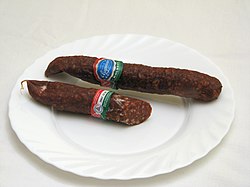This article needs additional citations for verification .(June 2021) |

Hungarian sausages are sausages found in the cuisine of Hungary. Hungary produces a vast number of sui sausage types. They may be boiled, fresh or dried, and smoked, with different spices and flavors, "hot" or "mild". Many were influenced by their neighbors and brethren.
Contents
- Cooked sausages
- Kolbász
- Hurka
- Other cooked sausages
- Uncooked sausages
- Szalámi
- See also
- References
- External links
These sausages may be eaten like a cold cut or used in a main course. Hungarian cuisine uses these different types of sausages in many ways such as in stews, soups, potato stews like "paprikás krumpli" (paprika-based stew with spicy sausage and potatoes), bean soups like Jókai bableves, [1] some goulash soup variations, pastry dishes, or even in salads.
The smoked sausages may contain bacon, ground pork, beef, boar or lamb, paprika, salt, garlic, black pepper, allspice, white pepper, caraway, nutmeg, zest, marjoram, cayenne pepper, sugar, white wine or cognac. Sausages may have additional ingredients like liver, mushroom, bread, rice, lemon juice, eggs, cream or milk. [2]
The meat is coarsely ground and salted. If garlic is added, it is mashed in water to produce a slurry and added to the meat along with spices. The sausage is then stuffed into natural casings in 1-foot links - usually using the small intestine of the pig. This traditionally took place outside on the fall day when a pig was slaughtered. The sausage is then hung overnight to allow the flavors to meld and some of the grease to drip out. It is now ready to be used fresh and unsmoked. The unsmoked sausages are typically roasted with sauerkraut or red or green cabbage, and served with mashed potatoes.
The dry sausages are cold smoked and hung to cure before consumption.

